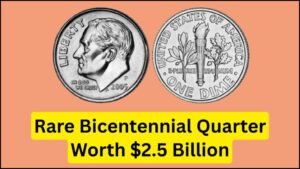The Lincoln Wheat Penny, a small copper coin often tossed into jars or forgotten in couch cushions, has some rare versions that can fetch up to $305,000 at auction. These tiny treasures, minted between 1909 and 1958, are a collector’s dream and a reminder that fortune might be hiding in plain sight. Let’s dive into the exciting world of numismatics and uncover why these pennies are worth so much, how to spot one, and what to do if you think you’ve struck gold—er, copper!
The Fascinating History of the Lincoln Wheat Penny
A Coin with a Presidential Legacy
In 1909, the United States Mint released the Lincoln Wheat Penny to celebrate the 100th anniversary of Abraham Lincoln’s birth. Designed by Victor David Brenner, it was the first U.S. coin to feature a real historical figure instead of symbolic images like Lady Liberty. The obverse showcases Lincoln’s profile, while the reverse sports two wheat stalks framing “ONE CENT” and “UNITED STATES OF AMERICA,” earning it the “Wheat Penny” nickname. This iconic design ran until 1958, making it a beloved piece of American history.
Why the 1943 Copper Penny Steals the Show
The real star of the Lincoln Wheat Penny saga is the 1943 copper penny. During World War II, copper was scarce, so the Mint switched to zinc-coated steel for pennies. However, a tiny number of copper pennies were mistakenly minted in 1943, with estimates suggesting only about 20 exist today. These rare coins are numismatic legends, with top specimens selling for as much as $305,000 due to their scarcity, historical significance, and minting error.
What Makes a Lincoln Wheat Penny Valuable?
Rarity and Minting Errors
The value of a Lincoln Wheat Penny hinges on a few key factors: rarity, condition, and minting errors. The 1943 copper penny is the crown jewel, but other rare versions, like the 1909-S VDB (with the designer’s initials) or the 1955 Double Die (with doubled text), can also command high prices. Fewer coins mean higher demand among collectors, driving up value.
Condition is King
A penny in pristine, uncirculated condition with sharp details and a reddish hue is worth exponentially more than a worn one. Coins are graded on a scale from 1 to 70, with higher grades fetching top dollar. For example, a 1914-D penny in near-mint condition recently sold for $305,000 due to its low mintage and excellent state.
How to Spot a $305,000 Penny
Simple Tests for the 1943 Copper Penny
Think you’ve found a valuable penny? Here’s how to check:
- Check the Date: Look for “1943” under Lincoln’s bust on the obverse.
- Magnet Test: A 1943 steel penny sticks to a magnet; a rare copper one doesn’t.
- Weigh It: Copper pennies weigh about 3.11 grams, while steel ones are lighter at 2.7 grams.
- Examine the Color: Copper pennies have a distinct reddish tone, even if toned with age.
- Watch for Fakes: Beware of copper-plated steel pennies or altered 1948 pennies (where the “8” is modified to look like a “3”).
Other Valuable Pennies to Look For
Beyond the 1943 copper penny, keep an eye out for:
- 1909-S VDB: Only 484,000 were minted, and they can fetch tens of thousands.
- 1955 Double Die: Look for doubled text or dates, a famous minting error.
- 1914-D: Low mintage makes this Denver-minted penny a collector’s prize.
Preserving Your Penny’s Value
Handle with Care
If you suspect you’ve found a rare penny, handle it only by the edges to avoid damaging the surface with finger oils. Never clean it—cleaning can slash its value. Store it in an acid-free, non-PVC holder in a cool, dry place to prevent tarnishing. Document where you found it for provenance, which can boost its appeal to collectors.
Getting It Authenticated
Take your penny to a reputable coin dealer or grading service like PCGS or NGC for professional authentication. Coin shows are also great for getting expert opinions. Avoid online scams and stick to trusted sources for appraisals.
Could You Have a Treasure in Your Change?
| Penny Type | Key Features | Estimated Value |
|---|---|---|
| 1943 Copper | Copper, non-magnetic, 3.11g | Up to $305,000 |
| 1909-S VDB | “S” mint mark, VDB initials | $10,000–$100,000 |
| 1955 Double Die | Doubled text/date | $1,000–$50,000 |
| 1914-D | “D” mint mark, low mintage | Up to $305,000 |
Conclusion
The Lincoln Wheat Penny is more than just pocket change—it’s a portal to history and a potential jackpot. From the ultra-rare 1943 copper penny to the coveted 1914-D, these coins remind us that treasure can hide in the most ordinary places. Next time you get change or rummage through an old coin jar, take a closer look. With a keen eye and a bit of luck, you might just find a $305,000 penny waiting to change your life. Happy hunting!
FAQs
How can I tell if my 1943 penny is copper or steel?
Use a magnet: steel pennies stick, copper ones don’t. Check the weight (3.11g for copper, 2.7g for steel) and look for a reddish copper color.
Should I clean my old pennies?
Never clean old coins! Cleaning damages the surface and can drastically reduce their value to collectors.
Where can I get my penny appraised?
Visit a reputable coin dealer, grading service like PCGS or NGC, or attend a coin show for expert appraisals. Some coin shops offer free or low-cost evaluations.
Are all Wheat Pennies valuable?
Most Wheat Pennies are worth just a few cents above face value. Only specific dates, mint marks, or error coins, like the 1943 copper or 1955 Double Die, command high prices.




